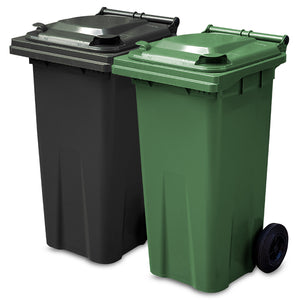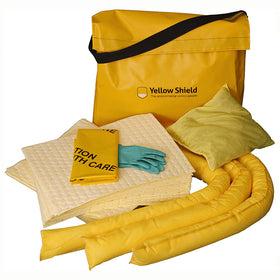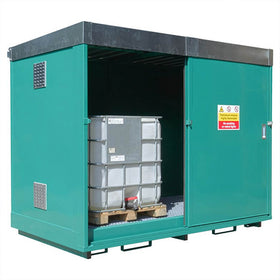10 Key Factors in Effective Spill Control
Spills of oils, fuels, chemicals and many other industrial fluids are an inevitable occurrence across warehouses and workplaces in the UK. However, the long-term effects of any spill will be largely determined by the preparedness of the first responders to the spill. Here are 10 key points to consider when assessing your companies spill procedure.
1. Have you done a Site Assessment for Spill Risks?
A site assessment for spill risks is the most important part of any effective spill control and must be the starting point. Even if your site only has a few simple liquids such as fuels, lubricants or cleaning fluids then regardless of the volume stored, an experienced member of your staff or a specialist spill risk assessor must carry out an assessment. Most suppliers of spill control equipment will conduct a site assessment free of charge.
2. Do you know your sites drainage plan?
Knowing your sites drainage plan will enable you to identify any potential routes for the escape of liquids away from the site and potentially, into the water course. Failure to prevent hazardous liquids entering the water course can result in criminal prosecution and a fine.
For a comprehensive spill prevention plan your site assessment will require;
• A plan of the surface water drains (legally marked blue)
• A plan of the foul water drains (legally marked red)
• Knowledge of the storage and movement of liquids on your site
For a complete guide to dealing with hazardous liquids near water see the Environment Agency’s Pollution Prevention Guidelines 3, 4, 5, 13, 22 and 21.
3. Have you conducted a full review of spill prevention practices before providing suitable clean up facilities?
Before finalising plans for the suitable clean up of a spill it is critical to assess the key factors involved in spill risk. These are namely the transporting, handling and storage of hazardous liquids. Ensuring that your site has done everything to minimise the risk of a spill will not only limit the potential for a spill but will allow for more effective spill control.
• Management procedures, supervision and detailed planning of liquid movements should be antecedent to the deployment of Spill Kits.
• Ensuring that your liquid stores are adequately bunded is a legal requirement under the remit of the Oil Storage Regulations (2001) and can be a costly enterprise. A thorough investigation of your sites liquid storage is therefore essential before planning and implementing any spill clean-up measures.
4. What are the key factors in determining spill response measures?
Even though a site spill assessment is important, with all the best laid plans and spill prevention measures in place accidental spills and leaks will still occur. Therefore the first questions that need to be addressed are;
• Where: Where are spillages most frequent and of the most serious consequences, and to where would it drain?
• What: What types of liquid are being spilled?
• How much: Estimate the likely volume of a spill.
5. What should be included in spill response measures?
The primary aim is to prevent pollutants from reaching the water course so in the event of a spill your first emergency response procedure should be to protect the drainage system.
• This can be achieved from various methods by either; installing Penstock rings to restrict the flow of liquid, using reusable or moulded drain covers or by fitting inflatable drain sealing systems permanently in the main drains.
• If you are using drain covers then these need to be located near to vulnerable drains or included as part of a spill kit.
Common practices should be reviewed at regular intervals to ensure that your site is compliant with the Environment Agencies guidelines. For instance, past Environment Agency reports have highlighted how vehicle washing in many industrial estates contravened EA guidelines. EA Pollution Prevention Guidelines 3 and 13 should be consulted to ensure strict adherence to the law.
6. Which spill kit is right for your site?
Spill kits are supplied in a variety of formats, General Purpose, Oil Only, Chemical and Specialist and range in size from 10 litres up to 1200 litres. The spill kit that will be right for your site will vary depending on the type and volume of the liquid stored on site.
In many cases a strategically placed spill kit will result in faster and more effective response so consider in your spill response measures:
• Where is a spill most likely to occur on site?
• Is there a suitable kit in place or can it be moved there quickly?
For instance, if you are transporting oil drums in a warehouse with forklift trucks then you would want to strategically place Oil only wheeled spill kits at various points throughout the warehouse so that they can be quickly moved into position in the event of a spill.
7. Do your operators appreciate the risks and consequences of a spill?
As part of a spill site risk assessment it is important to factor in how your staff would deal with such an event. In these events it is imperative that everyone who has a role to play is aware of what that role consists of and how best to undertake that role. Senior managers responsible for Health and Safety and Environmental issues are vital in conveying this message to staff and ensuring that detailed planning will result in effective action.
8. What spill response training should be offered to site operators?
Having the right products in the right place is only one part of the solution but carrying out professional spill training could make all the difference. Accredited spill training is provided by many spill control companies and provides a pro-active and efficient approach to spill prevention and control.
9. Do you audit your spill kits?
Regularly auditing spill kits is fundamental to having a thorough spill response plan and making sure that they are complete in the event of an emergency.
In some cases audit covers will have a tamper proof tape seal that when broken, will alert auditors that the kit has been used and that some of the absorbents inside might need checking and replacing.
To limit the potential for people using spill kits in non-emergency situations have a good supply of other absorbents ready for normal daily consumption and reserve spill kit use for emergencies only.
10. How can I find out more?
You can learn more on effective spill prevention and control by downloading and reading the relevant Environment Agency PPG’s or by calling or emailing us at Yellow Shield.



